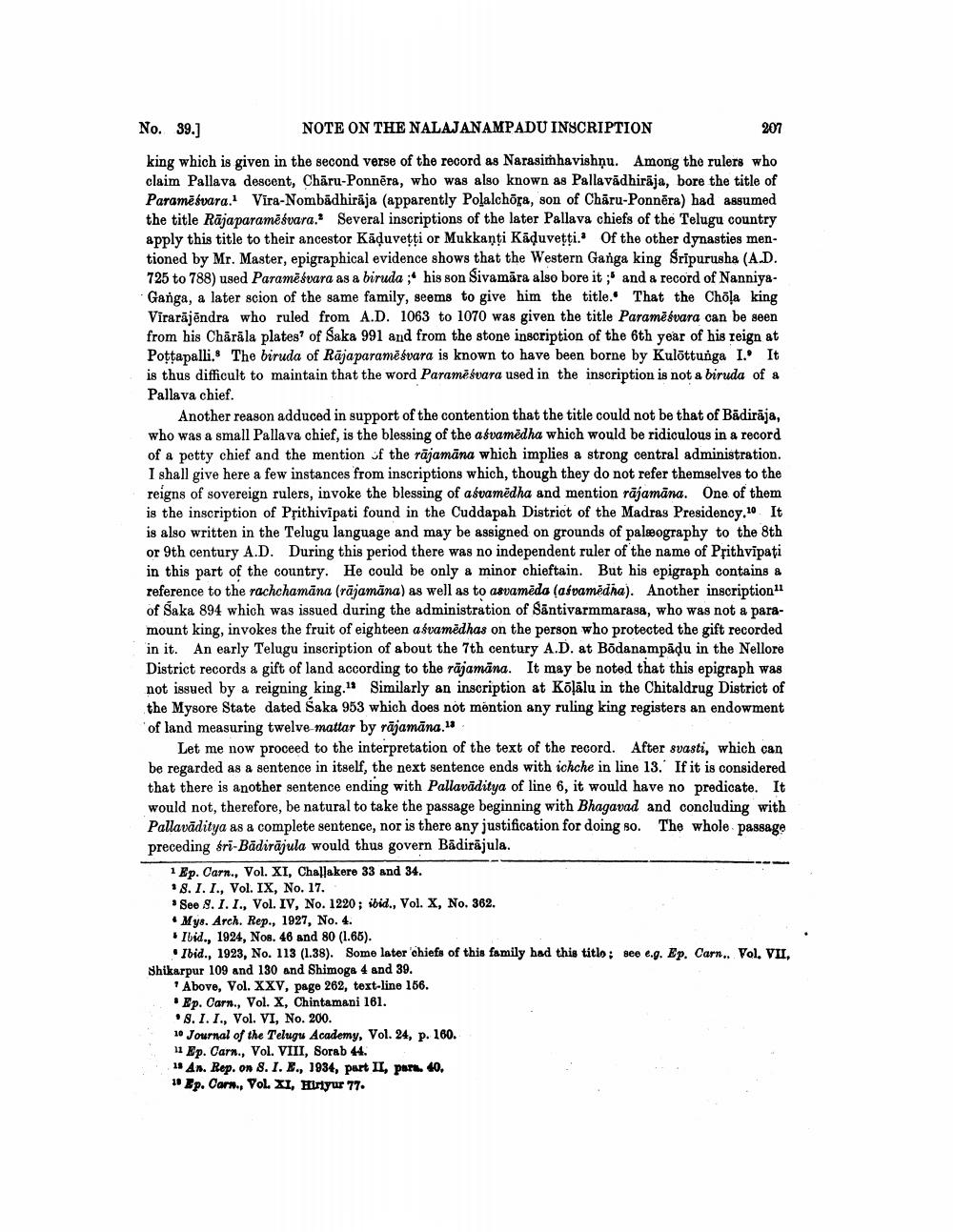________________
No. 39.] NOTE ON THE NALAJANAMPADU INSCRIPTION
207 king which is given in the second verse of the record as Narasimhavishņu. Among the rulers who claim Pallava descent, Chāru-Ponnēra, who was also known as Pallavādhirāja, bore the title of Paramëtvara. Vira-Nombädhiraja (apparently Polalchõra, son of Charu-Ponnēra) had assumed the title Rājaparamēśvara. Several inscriptions of the later Pallava chiefs of the Telugu country apply this title to their ancestor Kāduvetti or Mukkaņţi Kāduvetti.. Of the other dynasties mentioned by Mr. Master, epigraphical evidence shows that the Western Ganga king Sripurusha (A.D. 725 to 788) used Paramēšvara as a biruda ;' his son Sivamāra also bore it ;' and a record of NanniyaGanga, a later scion of the same family, seems to give him the title. That the Chöļa king Virarājēndra who ruled from A.D. 1063 to 1070 was given the title Paramēśvara can be seen from his Chārāla plates? of Saka 991 and from the stone inscription of the 6th year of his reign at Pottapalli. The biruda of Rāja paramē svara is known to have been borne by Kulõttunga I. It is thus difficult to maintain that the word Paramēśvara used in the inscription is not a biruda of a Pallava chief.
Another reason adduced in support of the contention that the title could not be that of Bădirāja, who was a small Pallava chief, is the blessing of the asvamēdha which would be ridiculous in a record of a petty chief and the mention of the rājamāna which implies a strong central administration. I shall give here a few instances from inscriptions which, though they do not refer themselves to the reigns of sovereign rulers, invoke the blessing of aśvamëdha and mention rājamāna. One of them is the inscription of Přithivipati found in the Cuddapah District of the Madras Presidency.10 It is also written in the Telugu language and may be assigned on grounds of paleography to the 8th or 9th century A.D. During this period there was no independent ruler of the name of Prithvipati in this part of the country. He could be only a minor chieftain. But his epigraph contains & reference to the rachchamāna (rājamāna) as well as to asvamēda (asvamēdna). Another inscription1 of Saka 894 which was issued during the administration of Sāntivarmmarasa, who was not a paramount king, invokes the fruit of eighteen aśvamëdhas on the person who protected the gift recorded in it. An early Telugu inscription of about the 7th century A.D. at Bödanampādu in the Nellore District records a gift of land according to the rājamāna. It may be noted that this epigraph was not issued by a reigning king. Similarly an inscription at Kõļālu in the Chitaldrug District of the Mysore State dated Saka 953 which does not mention any ruling king registers an endowment of land measuring twelve-mattar by räjamāna..
Let me now proceed to the interpretation of the text of the record. After svasti, which can be regarded as a sentence in itself, the next sentence ends with ichche in line 13.' If it is considered that there is another sentence ending with Pallavāditya of line 6, it would have no predicate. It would not, therefore, be natural to take the passage beginning with Bhagavad and concluding with Pallavāditya as a complete sentence, nor is there any justification for doing so. The whole passage preceding $ri-Bădirājula would thus govern Bădirājula.
1 Ep. Carn., Vol. XI, Challakere 33 and 34. *8.1.., Vol. IX, No. 17.
See 8.1.1., Vol. IV, No. 1220; ibid., Vol. X, No. 362. • Mys. Arch. Rep., 1927, No. 4. Ibid., 1924, Nos. 46 and 80 (1.65).
Ibid., 1923, No. 113 (1.38). Some later chiefs of this family had this titlo; see e.g. Ep. Carn.. Vol. VII, Shikarpur 109 and 130 and Shimoga 4 and 39.
Above, Vol. XXy, page 262, text-line 156. . Ep. Carn., Vol. X, Chintamani 161.
8.I.I., Vol. VI, No. 200. 10 Journal of the Telugu Academy, Vol. 24, p. 160. 11 Ep. Carn., Vol. VIII, Sorab 44. 13 An. Rep. on 8.1. E., 1934, part II, paru. 40. 10 Ep. Carn., Vol. XI, Hiriyur 77.




